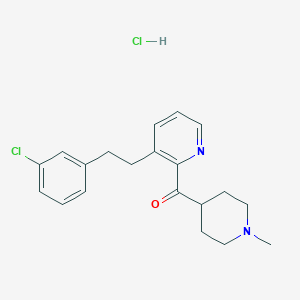
(3-(3-Chlorophenethyl)pyridin-2-yl)(1-methylpiperidin-4-yl)methanone hydrochloride
描述
(3-(3-Chlorophenethyl)pyridin-2-yl)(1-methylpiperidin-4-yl)methanone hydrochloride is a useful research compound. Its molecular formula is C20H24Cl2N2O and its molecular weight is 379.3 g/mol. The purity is usually 95%.
The exact mass of the compound this compound is unknown and the complexity rating of the compound is unknown. The United Nations designated GHS hazard class pictogram is Corrosive;Irritant;Environmental Hazard, and the GHS signal word is DangerThe storage condition is unknown. Please store according to label instructions upon receipt of goods.
BenchChem offers high-quality this compound suitable for many research applications. Different packaging options are available to accommodate customers' requirements. Please inquire for more information about this compound including the price, delivery time, and more detailed information at [email protected].
生物活性
(3-(3-Chlorophenethyl)pyridin-2-yl)(1-methylpiperidin-4-yl)methanone hydrochloride, also known by its CAS number 119770-60-4, is a compound with significant relevance in pharmaceutical chemistry. It is primarily recognized as an impurity in the synthesis of Loratadine, an antihistamine used to treat allergies. This article reviews the biological activity of this compound, highlighting its pharmacological properties, mechanisms of action, and relevant research findings.
- Molecular Formula : C20H24Cl2N2O
- Molecular Weight : 379.323 g/mol
- Melting Point : 183-185 °C
The compound exhibits biological activity through its interaction with various neurotransmitter systems. Its structure suggests potential affinities for dopamine and serotonin receptors, which are critical in modulating mood and behavior. The presence of the piperidine moiety is indicative of compounds that often exhibit psychoactive properties.
Antihistaminic Activity
Research indicates that this compound may possess antihistaminic properties similar to Loratadine. Studies have shown that derivatives of this compound can inhibit histamine release from mast cells, thereby reducing allergic responses.
Neurotransmitter Receptor Interaction
Studies involving receptor binding assays have demonstrated that this compound has a notable affinity for serotonin receptors (5-HT2A and 5-HT2C) and dopamine D2 receptors. This suggests potential applications in treating mood disorders and schizophrenia, although further studies are necessary to elucidate these effects fully.
Case Study 1: Antiallergic Effects
A study published in the Journal of Medicinal Chemistry explored the antihistaminic effects of related compounds. The results indicated that modifications to the piperidine ring could enhance receptor binding affinity and improve therapeutic efficacy against allergy symptoms .
Case Study 2: Neuropharmacological Assessment
In a neuropharmacological assessment, researchers evaluated the effects of this compound on animal models exhibiting anxiety-like behaviors. The findings suggested a reduction in anxiety levels, correlating with increased serotonin receptor activity .
Data Summary
| Property | Value |
|---|---|
| CAS Number | 119770-60-4 |
| Molecular Formula | C20H24Cl2N2O |
| Molecular Weight | 379.323 g/mol |
| Melting Point | 183 - 185 °C |
| Antihistaminic Activity | Yes |
| Receptor Affinity | 5-HT2A, 5-HT2C, D2 |
属性
IUPAC Name |
[3-[2-(3-chlorophenyl)ethyl]pyridin-2-yl]-(1-methylpiperidin-4-yl)methanone;hydrochloride | |
|---|---|---|
| Source | PubChem | |
| URL | https://pubchem.ncbi.nlm.nih.gov | |
| Description | Data deposited in or computed by PubChem | |
InChI |
InChI=1S/C20H23ClN2O.ClH/c1-23-12-9-17(10-13-23)20(24)19-16(5-3-11-22-19)8-7-15-4-2-6-18(21)14-15;/h2-6,11,14,17H,7-10,12-13H2,1H3;1H | |
| Source | PubChem | |
| URL | https://pubchem.ncbi.nlm.nih.gov | |
| Description | Data deposited in or computed by PubChem | |
InChI Key |
YDOROGMYGIAIPT-UHFFFAOYSA-N | |
| Source | PubChem | |
| URL | https://pubchem.ncbi.nlm.nih.gov | |
| Description | Data deposited in or computed by PubChem | |
Canonical SMILES |
CN1CCC(CC1)C(=O)C2=C(C=CC=N2)CCC3=CC(=CC=C3)Cl.Cl | |
| Source | PubChem | |
| URL | https://pubchem.ncbi.nlm.nih.gov | |
| Description | Data deposited in or computed by PubChem | |
Molecular Formula |
C20H24Cl2N2O | |
| Source | PubChem | |
| URL | https://pubchem.ncbi.nlm.nih.gov | |
| Description | Data deposited in or computed by PubChem | |
Molecular Weight |
379.3 g/mol | |
| Source | PubChem | |
| URL | https://pubchem.ncbi.nlm.nih.gov | |
| Description | Data deposited in or computed by PubChem | |
CAS No. |
119770-60-4 | |
| Record name | [3-[2-(3-Chlorophenyl)ethyl]-2-pyridinyl](1-methyl-4-piperidinyl)methanone hydrochloride | |
| Source | CAS Common Chemistry | |
| URL | https://commonchemistry.cas.org/detail?cas_rn=119770-60-4 | |
| Description | CAS Common Chemistry is an open community resource for accessing chemical information. Nearly 500,000 chemical substances from CAS REGISTRY cover areas of community interest, including common and frequently regulated chemicals, and those relevant to high school and undergraduate chemistry classes. This chemical information, curated by our expert scientists, is provided in alignment with our mission as a division of the American Chemical Society. | |
| Explanation | The data from CAS Common Chemistry is provided under a CC-BY-NC 4.0 license, unless otherwise stated. | |
| Record name | Methanone, [3-[2-(3-chlorophenyl)ethyl]-2-pyridinyl](1-methyl-4-piperidinyl)-, hydrochloride (1:1) | |
| Source | European Chemicals Agency (ECHA) | |
| URL | https://echa.europa.eu/substance-information/-/substanceinfo/100.129.458 | |
| Description | The European Chemicals Agency (ECHA) is an agency of the European Union which is the driving force among regulatory authorities in implementing the EU's groundbreaking chemicals legislation for the benefit of human health and the environment as well as for innovation and competitiveness. | |
| Explanation | Use of the information, documents and data from the ECHA website is subject to the terms and conditions of this Legal Notice, and subject to other binding limitations provided for under applicable law, the information, documents and data made available on the ECHA website may be reproduced, distributed and/or used, totally or in part, for non-commercial purposes provided that ECHA is acknowledged as the source: "Source: European Chemicals Agency, http://echa.europa.eu/". Such acknowledgement must be included in each copy of the material. ECHA permits and encourages organisations and individuals to create links to the ECHA website under the following cumulative conditions: Links can only be made to webpages that provide a link to the Legal Notice page. | |
Synthesis routes and methods I
Procedure details






Synthesis routes and methods II
Procedure details






体外研究产品的免责声明和信息
请注意,BenchChem 上展示的所有文章和产品信息仅供信息参考。 BenchChem 上可购买的产品专为体外研究设计,这些研究在生物体外进行。体外研究,源自拉丁语 "in glass",涉及在受控实验室环境中使用细胞或组织进行的实验。重要的是要注意,这些产品没有被归类为药物或药品,他们没有得到 FDA 的批准,用于预防、治疗或治愈任何医疗状况、疾病或疾病。我们必须强调,将这些产品以任何形式引入人类或动物的身体都是法律严格禁止的。遵守这些指南对确保研究和实验的法律和道德标准的符合性至关重要。













